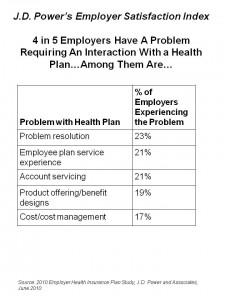 J.D. Power, an expert in understanding satisfaction across industries, has looked under the hood of employers and their satisfaction with health plans. In summary: it’s not only about the benefits and costs when it comes to health plan satisfaction.
J.D. Power, an expert in understanding satisfaction across industries, has looked under the hood of employers and their satisfaction with health plans. In summary: it’s not only about the benefits and costs when it comes to health plan satisfaction.
For employers, satisfaction is also based on near-equal parts of “service” in 3 guises: account servicing from the employer’s point of view (where more communication from the plan is seen as better than less); employee plan service experiences; and problem resolution.
For the 4 in 5 employers who have had problems with health plans (that’s 79% of employers), it’s less about costs and benefit design than service — especially resolving problems, as shown in the table.
Health Populi’s Hot Points: What was most striking to me in this survey was the fact that J.D. Power found that the incidence of problems is over twice as high at 79% for employers with their health plans as it is in the small business banking industry, where only one-third of small business bank customer have experienced a problem. That means, 4 in 5 of health plans’ customers (employers) have bad feelings about the plans to whom they pay $zillions in health plan premiums. As employers are the virtual life-blood of health plan companies’ commercial business, this percentage seems surprisingly high.
This data point is especially shocking in the current era of health plan dis-enrollment. Since the start of the recession in late 2008, there has been a steady decline in health plan enrollment, which is expected to continue. Between 4Q08 and 4Q09, for example, WellPoint lost 1.3 million enrollees and UnitedHealth lost 900,000 members.
J.D. Power’s model points to communication as a key building-block for employer engagement that leads to greater satisfaction. Less communication leads to lower engagement, thus lower satisfaction. As problem resolution is a key satisfaction lever for helath plans, it would seem that tools that bolster communication that helps solve problems would be a no-brainer for health plans to invest in. Yet “the mail” is currently the communication mode of choice for most health plans, J.D. Power found: “Mail is the most prevalent method used by carriers to distribute information to employers, but this is the least satisfying communication channel.”
Here’s another example of a part of the health care system under-automating what other industry sectors have long-since modernized: moving from mail to e-mail and self-service websites. Am I surprised? No, because I know that the U.S. health system squanders around $30 billion in health care administrative waste.




 Interviewed live on BNN Bloomberg (Canada) on the market for GLP-1 drugs for weight loss and their impact on both the health care system and consumer goods and services -- notably, food, nutrition, retail health, gyms, and other sectors.
Interviewed live on BNN Bloomberg (Canada) on the market for GLP-1 drugs for weight loss and their impact on both the health care system and consumer goods and services -- notably, food, nutrition, retail health, gyms, and other sectors. Thank you, Feedspot, for
Thank you, Feedspot, for  As you may know, I have been splitting work- and living-time between the U.S. and the E.U., most recently living in and working from Brussels. In the month of September 2024, I'll be splitting time between London and other parts of the U.K., and Italy where I'll be working with clients on consumer health, self-care and home care focused on food-as-medicine, digital health, business and scenario planning for the future...
As you may know, I have been splitting work- and living-time between the U.S. and the E.U., most recently living in and working from Brussels. In the month of September 2024, I'll be splitting time between London and other parts of the U.K., and Italy where I'll be working with clients on consumer health, self-care and home care focused on food-as-medicine, digital health, business and scenario planning for the future...